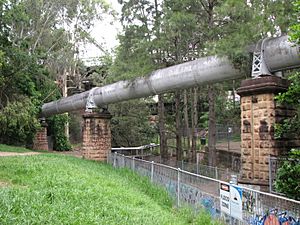Lewisham Sewage Aqueduct facts for kids
Quick facts for kids Lewisham Sewage Aqueduct |
|
|---|---|
 |
|
| Location | Grosvenor Crescent, Summer Hill, Inner West Council, Sydney, New South Wales, Australia |
| Built | 1900 |
| Architect | Sewerage Construction Branch; Department of Public Works |
| Owner | Sydney Water |
| Official name: Lewisham Sewage Aqueduct | |
| Type | state heritage (built) |
| Designated | 18 November 1999 |
| Reference no. | 1326 |
| Type | Sewage Aqueduct |
| Category | Utilities - Sewerage |
| Builders | Sewerage Construction Branch, Department of Public Works |
| Lua error in Module:Location_map at line 420: attempt to index field 'wikibase' (a nil value). | |
The Lewisham Sewage Aqueduct is a special bridge built to carry wastewater. It's located in Gadigal Reserve, near Summer Hill in Sydney, New South Wales. This important structure was designed by the Public Works Department and finished in 1900. Today, Sydney Water owns and looks after it. It's so important that it was added to the New South Wales State Heritage Register in 1999.
History of the Aqueduct
The Lewisham sewage aqueduct was completed in 1900. It was built as part of a much larger system. This system was called the Southern and Western Suburbs Ocean Outfall Sewer, or SWSOOS for short.
The aqueduct's job was to carry wastewater from areas like Dobroyd Point, Haberfield, and parts of Ashfield. It helped these growing suburbs get proper sewerage services. The Public Works Department designed and built this aqueduct. They started the design work in 1897.
The aqueduct was built to carry sewage over the Long Cove Creek stormwater channel. This channel is near the Lewisham railway viaduct. Imagine a bridge, but instead of cars, it carries water from homes and businesses.
The aqueduct is about 85 metres (280 feet) long. It has six sections, or spans. Two spans are 12 metres (40 feet) long, and four are 15 metres (50 feet) long. The main pipe that carries the sewage is made of steel. It's shaped like an oval, about 1.4 metres (4.5 feet) tall and 1 metre (3.5 feet) wide.
This steel pipe rests on strong concrete pillars. These pillars are covered with decorative sandstone blocks. The tallest pillar is about 7.3 metres (24 feet) high. The oval shape of the pipe helps keep the wastewater flowing smoothly, even when there isn't much of it.
The Lewisham Sewage Aqueduct is one of six similar structures built in Sydney between 1895 and 1901. Other examples include aqueducts at Whites Creek and Mosman Bay.
What it Looks Like
The Lewisham sewage aqueduct has two main parts. First, there's the oval-shaped metal pipe that carries the sewage. Second, there are the strong concrete pillars that hold it up. These pillars are covered with beautiful sandstone blocks. They even have decorative bases and tops.
The steel pipe sections are joined together with rivets, like old-fashioned metal structures. The pipe is connected to the pillars with special supports. All these parts look just as they did when they were first built.
The aqueduct ends on both sides with stone walls called abutments. It sits in a wide, shallow valley. Nearby, there's also a railway line that crosses the valley on its own bridge. There's also a brick and concrete stormwater channel built around 1899.
Seeing these three old structures—the aqueduct, the railway bridge, and the stormwater channel—all together is like looking at a piece of history. They show how important public works were in the late 1800s and early 1900s. The aqueduct is still working today, carrying sewage for the local area.
Why it's Important
The Lewisham sewage aqueduct, finished in 1900, is a very important part of Sydney's history. It's a key piece of the large sewer system that helped suburbs like Haberfield and Ashfield grow. These areas developed a lot between the 1900s and 1920s.
This aqueduct is special because of its unique design. It's the only one in Australia with a riveted, oval-shaped steel pipe for carrying sewage. Even though it's a functional structure, it's also quite beautiful. It has decorative metal lattice work and fancy sandstone pillars.
Its location is also unique. Being next to the stormwater channel and the railway line creates a fascinating historical scene. It shows how different types of public works were built close together.
The aqueduct is important for several reasons:
- Historical Value: It shows how Sydney's sewerage system developed and helped new suburbs grow.
- Design and Engineering: Its unique riveted steel pipe and decorative features show great skill.
- Community Connection: Because it's next to the railway, many people in Sydney might know about it.
- Research Potential: Its rare design can teach us more about old engineering methods.
- Rarity: The large, old steel carrier makes it very rare in Australia.
- Good Example: It's a great example of how sewage systems were built in Sydney.
The Lewisham Sewage Aqueduct was added to the New South Wales State Heritage Register on 18 November 1999.
Images for kids





